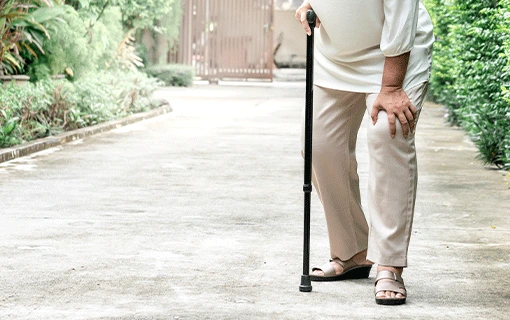Conditions / Osteoporosis
Osteoporosis

Overview
Osteoporosis is a progressive bone disease characterized by decreased bone density and strength, making bones more fragile and susceptible to fractures. It occurs when the body loses too much bone mass or doesn’t make enough bone, leading to a thinning of the bone tissue. As a result, bones become brittle and are more likely to break, especially in the hips, spine, and wrists. Osteoporosis often develops silently over many years, with no symptoms until a fracture occurs. It is more common in older adults, particularly postmenopausal women, due to hormonal changes, but it can also affect men and younger individuals. While osteoporosis cannot be reversed, treatments can help prevent further bone loss and reduce the risk of fractures.
Symptoms
Osteoporosis may not present any symptoms until a fracture occurs. However, common signs that may develop over time include:
• Fractures: Broken bones, particularly in the spine, hips, or wrists, often occur with little to no trauma.
• Back pain: Persistent pain in the back due to fractures or collapse of vertebrae, which may result in a stooped posture.
• Loss of height: A decrease in height over time, often accompanied by a stooped or hunched posture (kyphosis).
• Brittle nails and skin: Osteoporosis can sometimes cause brittle nails or dry, fragile skin, although these are not direct indicators.
When to see a doctor
Consult a doctor if you experience:
• Unexplained fractures, especially after minimal or no trauma.
• Persistent or severe back pain, particularly if it is associated with a recent injury or fall.
• A noticeable decrease in height or a stooped posture.
Seek immediate medical attention if you experience:
• Severe back pain after a fall or injury, which could indicate a spinal fracture.
• Difficulty moving or walking due to hip fractures.
Causes
Osteoporosis occurs when the process of bone remodeling—where old bone is replaced by new bone—becomes unbalanced. As we age, bone mass is lost more rapidly than it is replaced. The condition is influenced by several factors, including:
• Hormonal changes: A decrease in estrogen levels after menopause in women and a drop in testosterone levels in men can accelerate bone loss.
• Nutritional deficiencies: A lack of calcium, vitamin D, and other nutrients essential for bone health can weaken bones over time.
• Genetic factors: Family history plays a significant role in bone health, as osteoporosis tends to occur in families.
• Lifestyle factors: Lack of physical activity, smoking, excessive alcohol consumption, and poor nutrition can contribute to the development of osteoporosis.
• Medications and health conditions: Certain medications, such as corticosteroids, and conditions like hyperthyroidism or rheumatoid arthritis, can increase the risk of osteoporosis.
Risk Factors
Risk factors for osteoporosis include:
• Age: The risk of osteoporosis increases with age, especially in people over 50 years old.
• Gender: Women are more likely to develop osteoporosis, especially after menopause, due to lower estrogen levels.
• Family history: A family history of osteoporosis or fractures can increase the risk of developing the condition.
• Bone structure and body weight: People with smaller body frames and lower bone mass are at greater risk.
• Lack of physical activity: Sedentary lifestyles, particularly in older adults, contribute to bone weakness.
• Nutritional factors: A diet low in calcium and vitamin D can impair bone strength.
• Medications: Long-term use of corticosteroids and other medications that affect bone health may increase the risk of osteoporosis.
• Other health conditions: Conditions such as rheumatoid arthritis, celiac disease, or hyperthyroidism can increase the likelihood of developing osteoporosis.
Complications
Osteoporosis increases your risk of developing:
• Fractures
• Chronic pain
• Decreased mobility
• Loss of height and poor posture
• Emotional and mental health challenges
Medical Risk
Medications used to treat osteoporosis—such as bisphosphonates, hormone therapy, and selective estrogen receptor modulators (SERMs)—help strengthen bones by inhibiting bone loss and promoting bone formation. While these medications are generally effective, they may increase the risk of certain side effects, including gastrointestinal issues, blood clots, or jawbone problems (osteonecrosis). Additionally, people with osteoporosis who take medications for other conditions may experience side effects that impact bone health, such as steroid-induced bone loss.
Medications We Offer
• Evenity
• Prolia
• Reclast / Zoledronic Acid
